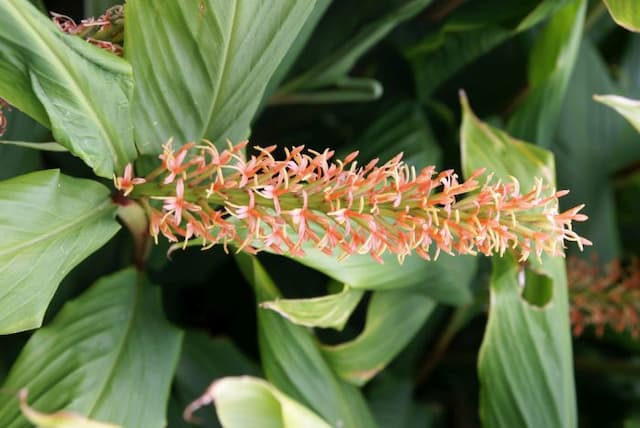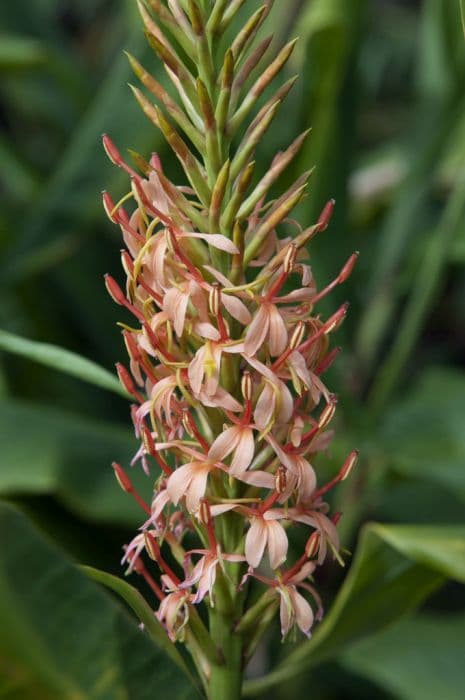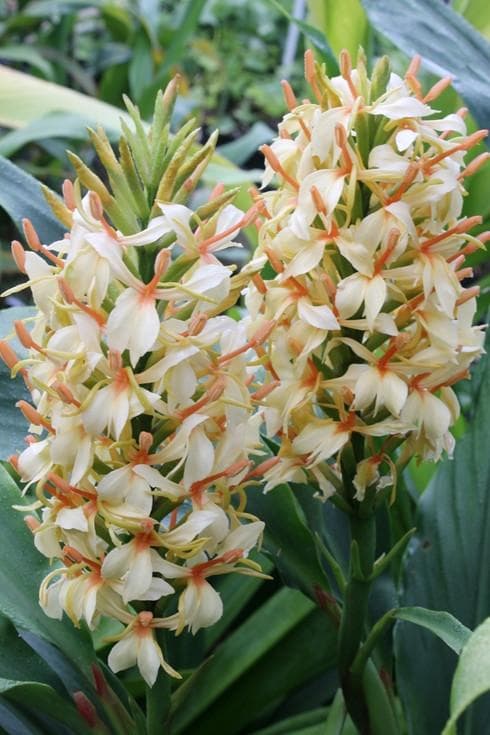Red ginger Hedychium coccineum
ABOUT
The plant commonly known as the red ginger features striking and bold floral displays. Its flowers are vibrant in color, ranging from fiery red to bright orange hues, and are known for their resemblance to the exotic blooms of the ginger family. Each flower is shaped like a funnel, opening to reveal delicate petals that form an intricate pattern. These flowers are organized in dense cone-shaped clusters, making the display even more spectacular. The foliage of the red ginger is lush and tropical in appearance; its leaves are long, broad, and glossy with a deep green shade that contrasts beautifully with the vivid tones of the flowers. The leaves grow in an alternate fashion, extending outwards on each side of the tall, sturdy stems, which enhance the plant's attractive structure and form. Overall, the red ginger is admired for its ornamental beauty and its ability to add a touch of the tropics to any setting where it is grown.
About this plant
 Names
NamesFamily
Zingiberaceae
Synonyms
Red Ginger Lily, Scarlet Ginger Lily, Orange Bottlebrush Ginger, Red Butterfly Ginger
Common names
Hedychium coccineum, Hedychium aurantiacum, Hedychium flavescens, Hedychium flavum, Hedychium luteum, Hedychium longiflorum, Hedychium panznerianum, Hedychium spicatum, Hedychium villosum, Hedychium spanneri.
 Toxicity
ToxicityTo humans
The Red Ginger is not typically known for being toxic to humans. Injuries or poisoning from this plant are rare, and there's no widespread documentation of toxicity for humans. However, it is always advisable to avoid ingesting plants that are not commonly recognized as food, as they could cause unexpected allergic reactions or gastrointestinal discomfort.
To pets
The Red Ginger is not listed as toxic to pets by major animal poison control resources. However, similar to the general advice given to humans, it's best to prevent pets from ingesting this or any ornamental plant because of the potential for mild stomach upset or the risk of an allergic reaction. If a pet does ingest some of the Red Ginger and shows adverse symptoms, consult a veterinarian.
 Characteristics
CharacteristicsLife cycle
Perennials
Foliage type
Deciduous
Color of leaves
Green
Flower color
Orange
Height
6 feet (1.83 meters)
Spread
2 feet (0.61 meters)
Plant type
Herb
Hardiness zones
8
Native area
Asia
Benefits
 General Benefits
General Benefits- Ornamental Value: Hedychium coccineum, commonly known as Red Ginger, is valued for its attractive red or orange flowers which enhance the aesthetics of gardens, parks, and landscapes.
- Habitat for Wildlife: The flowers provide nectar for pollinators such as butterflies and bees, thereby supporting local biodiversity.
- Fragrance: Red Ginger emits a pleasant fragrance that can create a sensory experience in gardens and indoor settings.
- Hardscaping: Due to its lush foliage and showy flowers, it can be used to create dramatic effect in garden borders or as a focal point in floral arrangements.
- Cultural Significance: In certain cultures, Red Ginger is used in traditional events and ceremonies for its beauty and symbolism.
- Low Maintenance: This plant is known to require minimal care compared to other ornamentals, making it suitable for gardeners of varying expertise levels.
 Medical Properties
Medical PropertiesThis plant is not used for medical purposes.
 Air-purifying Qualities
Air-purifying QualitiesThis plant is not specifically known for air purifying qualities.
 Other Uses
Other Uses- Hedychium coccineum, commonly known as the Scarlet Ginger Lily, can be used as a source of dye; the rhizomes may impart a color when treated and used in textile dyeing.
- In certain cultures, the flowers of Scarlet Ginger Lily are utilized in floral arrangements and religious offerings due to their vibrant color and exotic appearance.
- The aromatic nature of the Scarlet Ginger Lily flowers makes them suitable for creating natural fragrances and perfumes.
- Scarlet Ginger Lily can be used as a pest deterrent in organic farming practices due to its strong scent that repels certain insects.
- The plant is sometimes cultivated as an ornamental pond or water garden feature, with its lush foliage and flowers enhancing the aquatic landscape.
- The fibrous roots of Scarlet Ginger Lily are occasionally used in crafting and weaving, in the production of ropes or baskets in traditional crafts.
- In horticulture, the Scarlet Ginger Lily can be used as a parent in hybridization to create new ornamental flower varieties.
- The Scarlet Ginger Lily's large leaves can be used in tropical themed decorations or as natural platters and wrappers for serving food in eco-friendly catering services.
- The plant's erect and tall growth habit can be utilized in creating living fences or privacy screens in home gardens.
- In educational settings, the Scarlet Ginger Lily can serve as an example plant for botany students to study rhizomatous growth and tropical plant morphology.
Interesting Facts
 Feng Shui
Feng ShuiThe Red Ginger is not used in Feng Shui practice.
 Zodiac Sign Compitability
Zodiac Sign CompitabilityThe Red Ginger is not used in astrology practice.
 Plant Symbolism
Plant Symbolism- Exotic Beauty: Often referred to as the Red Ginger, Hedychium coccineum is admired for its vibrant and exotic flowers, symbolizing unique and striking beauty.
- Attraction: The intense red color of Red Ginger blooms is traditionally associated with attraction and allure, making it a symbol for the power of magnetism and charm.
- Sensuality: With its lush, fragrant flowers, Red Ginger can be seen as a symbol of sensuality and the pleasures of the senses.
- Prosperity: In some cultures, the Red Ginger is considered a harbinger of wealth and prosperity, likely due to its lush appearance and association with the tropics.
- Diversity: Representing the rich diversity of tropical flora, Red Ginger stands as a symbol of the variety and abundance of nature.
 Water
WaterThe Red Ginger requires thorough watering about once a week, but the frequency may vary depending on the climate and the environment. During the growing season, it's important to keep the soil consistently moist but not soggy. In general, provide approximately one gallon of water per week, ensuring it's distributed evenly around the plant. In hotter, drier conditions, you may need to water more often to maintain soil moisture levels. Cut back on watering during the winter when the plant is not actively growing.
 Light
LightRed Ginger thrives best in partial shade to dappled sunlight. It's important to protect it from the direct, harsh afternoon sun, which can scorch the leaves. A spot that receives bright, indirect light for most of the day with some protection from intense midday rays is ideal. This tropical plant can also adapt to conditions with less light, but its flowering may be affected.
 Temperature
TemperatureThe Red Ginger prefers warm temperatures and needs to be in an environment that maintains a range between 60 and 80 degrees Fahrenheit. This plant can tolerate a minimum temperature of around 50 degrees Fahrenheit, but sustained cold can damage the plant. Ideal growing conditions mimic its tropical origins, so it's essential to avoid areas that drop below the minimum temperature range.
 Pruning
PruningPruning the Red Ginger is essential for removing dead or yellowing leaves and spent flower stalks to encourage healthy growth and improve air circulation. It should be pruned in late winter or early spring before new growth begins. Cut back any old stems to ground level, and if the plant is overgrown, you can selectively prune to shape the plant and maintain its size. Pruning is typically done annually.
 Cleaning
CleaningAs needed
 Soil
SoilThe Scarlet Ginger Lily thrives in a rich, loamy soil mix with good drainage. Aim for a soil pH between 6.1 to 6.5. A mix of two parts garden soil, one part sand, and one part well-rotted compost or manure will create an ideal growing medium for this plant.
 Repotting
RepottingScarlet Ginger Lily should be repotted every 2-3 years or when it becomes root-bound. Spring is the best time for repotting to allow the plant to establish in the fresh soil before the growing season.
 Humidity & Misting
Humidity & MistingScarlet Ginger Lily prefers high humidity levels, ideally between 60-80%. Providing adequate humidity is crucial for mimicking its natural tropical habitat.
 Suitable locations
Suitable locationsIndoor
Place in bright, indirect light and maintain high humidity for Scarlet Ginger Lily.
Outdoor
Plant in partial shade and protect from cold for optimal Scarlet Ginger Lily growth.
Hardiness zone
7-10 USDA
 Life cycle
Life cycleThe Hedychium coccineum, commonly known as the Scarlet Ginger Lily, begins its life cycle when seeds or rhizomes germinate in warm, moist conditions, typically in spring or early summer. After germination, the plant develops lance-shaped leaves and a robust root system. As it matures, the Scarlet Ginger Lily produces tall flowering stalks with fragrant, brightly colored blooms that attract pollinators, typically in late summer or early fall. After pollination, the flowers develop into seed capsules that, once ripe, will burst open to release seeds for dispersal. If conditions allow, the plant's rhizomes will spread laterally, creating clumps that can give rise to new shoots. During winter or periods of cold, the foliage dies back, and the plant enters a dormancy phase, relying on its rhizomes' stored energy until favorable conditions for growth return.
 Propogation
PropogationPropogation time
Spring to Summer
The Scarlet Ginger Lily (Hedychium coccineum) can be propagated through division, which is the most popular method of propagation for this plant. The best time to divide is in the spring when the plant is just coming out of dormancy but there is still ample time for the new plants to get established before the growing season. To propagate by division, dig up the rhizomes after the foliage has died back or just before new growth starts. Carefully separate the rhizomes, ensuring that each division has at least one growth bud. Replant the divisions at the same depth they were growing before, which is typically about 2 to 4 inches (5 to 10 centimeters) deep, and water them well. Divisions should be spaced about 12 inches (approximately 30 centimeters) apart to allow for growth and ventilation. With proper care, these newly planted divisions will develop into vigorous plants that will bloom in the following seasons.









